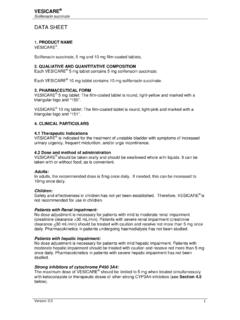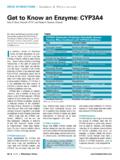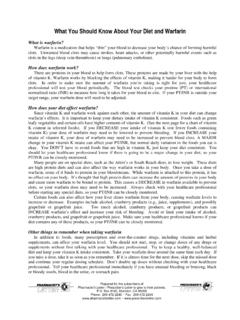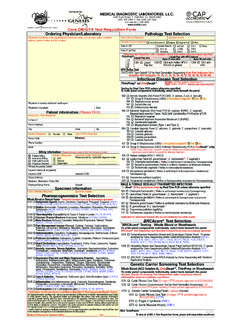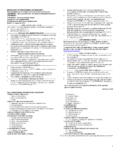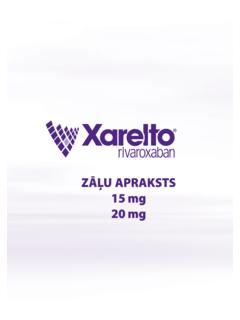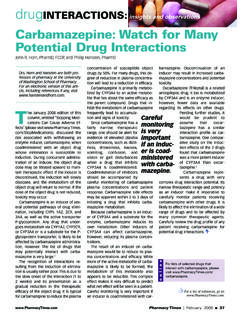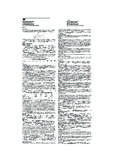Transcription of Cariprazine for the Treatment of Schizophrenia: A Review ...
1 Cariprazine is an antipsychotic medication and received approval by the Food and Drug Administration for the Treatment of schizophrenia in September 2015. Cariprazine is a dopamine D3 and D2 receptor partial agonist, with a preference for the D3 receptor. Cariprazine is also a partial agonist at the serotonin 5-HT1A receptor and acts as an antagonist at 5-HT2B and 5-HT2A receptors. The recommended dose range of Cariprazine for the Treatment of schizophrenia is 6 mg/d; the starting dose of mg/d is potentially therapeutic. Cariprazine is administered once daily and is primarily metabolized in the liver through the CYP3A4 enzyme system and, to a lesser extent, by CYP2D6.
2 There are two active metabolites of note, desmethyl- Cariprazine and didesmethyl- Cariprazine ; the latter s half-life is substantially longer than that for Cariprazine and systemic exposure to didesmethyl- Cariprazine is several times higher than that for Cariprazine . Three positive, 6-week, Phase 2/3, randomized controlled trials in acute schizophrenia dem-onstrated superiority of Cariprazine over placebo. Pooled responder rates were 31% for Cariprazine 6 mg/d vs. 21% for placebo, resulting in a number needed to treat (NNT) of 10. In a 26 72 week, randomized withdrawal study, significantly fewer patients relapsed in the Cariprazine group compared with placebo ( vs.)
3 , resulting in an NNT of 5. The most commonly encountered adverse events (incidence 5% and at least twice the rate of placebo) are extrapyramidal symptoms (number needed to harm [NNH] 15 for Cariprazine 3 mg/d vs. placebo and NNH 10 for 6 mg/d vs. placebo) and akathisia (NNH 20 for 3 mg/d vs. placebo and NNH 12 for 6 mg/d vs. placebo). Short-term weight gain appears small (approximately 8% of patients receiving Cariprazine 6 mg/d gained 7% body weight from baseline, compared with 5% for those randomized to placebo, resulting in an NNH of 34). Caripra-zine is associated with no clinically meaningful alterations in metabolic variables, prolactin, or the ECG QT interval.
4 Cariprazine is also approved for the acute Treatment of manic or mixed episodes associated with bipolar I disorder. Clinical trials are ongoing in patients with acute bipolar I depression and as adjunctive Treatment to antidepressant therapy in patients with major depressive disorder. New Drug ReviewCariprazine for the Treatment of schizophrenia : A Review of this Dopamine D3-Preferring D3/D2 Receptor Partial Agonist1 New York Medical College, Valhalla, NY, USAA ddress for correspondence: Leslie Citrome, MD, MPH, 11 Medical Park Drive, Suite 106, Pomona, NY 10970, USAP hone: 845-362-2081; Fax: 845-362-8745;E-mail: March 7, 2016; Revised: April 3, 2016.
5 Accepted: May 3, 2016 Leslie Citrome 1 AbstractClinical schizophrenia & Related Psychoses Summer 2016 109 Introduction Cariprazine received approval by the Food and Drug Administration (FDA) in September 2015 for the Treatment of schizophrenia and for the acute Treatment of manic or mixed episodes associated with bipolar I disorder Key Words: schizophrenia , Cariprazine , Antipsychotic, Dopamine, Psychopharmacology (1), based on a clinical development program well described in the Drug Approval Package available on the FDA s web-site (2). Cariprazine is the third dopamine receptor partial agonist antipsychotic to become available, joining aripipra-zole and brexpiprazole; the former now available as a generic medication and the latter as a branded product approved in 2015 (3-5).
6 In general, having additional choices for anti-psychotic medications is beneficial, as the different agents vary in their tolerability profiles and finding interventions that are suitable for an individual patient can be challenging (6-8). This paper reviews the pharmacology of Cariprazine and the evidence supporting its use in persons with schizo-phrenia. A literature search was conducted using the What are number needed to treat (NNT) and number needed to harm (NNH)?* P-values, even as low as p< , do not necessarily mean that a result is clinically relevant. In order to determine possible clinical relevance ( , clinical significance), effect size needs to be evaluated.
7 Number needed to treat (NNT) and number needed to harm (NNH) are measures of effect size that are clinically intuitive. NNT answers the question: How many patients would you need to treat with Intervention A instead of Intervention B before you would expect to encounter one additional positive outcome of interest? NNH answers the question: How many patients would you need to treat with Intervention A instead of Intervention B before you would expect to encounter one additional outcome of interest that you would like to avoid? NNT (used for desired outcomes) and NNH (used for undesired outcomes) are simple to calculate: A=frequency of outcome for Intervention A B=frequency of outcome for Intervention B NNT or NNH=1/(A-B)For example, if giving a test medication results in response 50% of the time and giving placebo results in response 25% of the time, NNT for response for the test medication vs.
8 Placebo is 1/(50%-25%)=1/( )=1/( )=4. Thus, for every 4 persons given the test medication instead of placebo, you would expect to encounter one additional psychotropic medications for most indications have NNT values between 3 and 9 for clinically relevant definitions of response. The lower the NNT the more often desired outcomes are encountered. On the other hand, higher NNH values are optimal, so that adverse outcomes are seldom values 10 or greater generally denote tolerability outcomes that are not excessively problematic; however, there are always exceptions if the adverse effect is serious and/or persistent in that case desirable NNH values could be much higher.
9 On the other hand, a single-digit NNH ( , <10) may be acceptable if the adverse event is mild or moderate, does not lead to discontinuation, is temporary or causes little distress, and does not pose a serious health risk, or if a Treatment has good (single-digit NNT) efficacy and there is a compelling need for efficacy that mitigates the low NNH tolerability additional tutorial for the use of NNT and NNH that is free to access can be found at *Reprinted from McEvoy JP, Citrome L: Brexpiprazole for the Treatment of schizophrenia : a Review of this novel serotonin-dopamine activity modulator. Clinical schizophrenia & Related Psychoses 2016;9(4) Clinical schizophrenia & Related Psychoses Summer 2016ter nM vs.
10 NM and nM for the two types of D2 receptors assayed (1, 10, 11). Cariprazine is also a partial agonist at the serotonin 5-HT1A receptor (Ki value nM). Cariprazine acts as an antagonist at 5-HT2B and 5-HT2A receptors, with high and moderate binding affinity (Ki val-ues nM and nM, respectively). Moderate affinity is also observed at the histamine H1 receptor (Ki value nM). Cariprazine has lower binding affinity to the serotonin 5-HT2C and 1A-adrenergic receptors (Ki values 134 nM and 155 nM, respectively) and has no appreciable affinity for cholinergic muscarinic receptors (IC50>1,000 nM). Wheth-er targeting the dopamine D3 receptor over the dopamine D2 receptor is clinically advantageous remains unknown but, theoretically, dopamine D3 preferring agents may exert pro-cognitive effects, as evidenced in animal studies (12-14).




